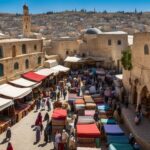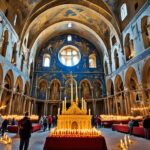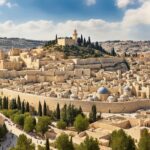Welcome to our journey through the fascinating history of Bethlehem, a city steeped in rich historical significance and biblical heritage. Situated in the West Bank, Bethlehem is known by its Arabic name, Bayt Laḥm, and its Hebrew name, Bet Leḥem. This ancient town holds a prominent place in both the Old Testament and the New Testament, making it a captivating destination for religious pilgrims and history enthusiasts alike.
Key Takeaways:
- Bethlehem is a town in the West Bank, holding significant historical and biblical importance.
- It is mentioned in the Old Testament as Bethlehem Ephrathah, the birthplace of King David.
- In Christian tradition, Bethlehem is celebrated as the birthplace of Jesus Christ.
- The Church of the Nativity, located on the site of the Nativity, is a major pilgrimage destination.
- Bethlehem’s cultural heritage includes the traditional crafts of mother-of-pearl and olive wood carving.
Origins and Biblical References
Bethlehem holds a significant place in biblical accounts and is mentioned in the Old Testament as Bethlehem Ephrathah or Bethlehem-Judah. The town’s historical and cultural significance is highlighted by its association with various biblical events and figures.
- One of the notable references to Bethlehem is the death of Rachel, the beloved wife of Jacob, who was buried near the town (Genesis 35:19).
- Bethlehem is also connected to the story of Ruth, whose husband and sons died in the land of Moab. Ruth later returned with her mother-in-law, Naomi, to Bethlehem, where she found solace and eventually married Boaz. Their son Obed became the grandfather of King David (Ruth 1:1-22, Ruth 2:1-4:22).
- Speaking of King David, he was not only born in Bethlehem but was also anointed as king of Israel in this historically significant town (1 Samuel 16:1-13).
These biblical references underscore Bethlehem’s importance in Israelite history and make it a site of great historical and cultural significance.
Bethlehem’s biblical connections have attracted religious pilgrims and tourists from around the world for centuries. It is a place where visitors can retrace the footsteps of biblical characters and immerse themselves in the rich tapestry of history that this ancient town offers.
Jesus and Bethlehem
According to Christian tradition, Bethlehem holds a significant place in religious history as the birthplace of Jesus Christ. The Gospels of Matthew and Luke mention Bethlehem as the town where Mary and Joseph traveled for the census, eventually leading to the birth of Jesus in a humble manger.
“And she brought forth her firstborn Son, and wrapped Him in swaddling cloths, and laid Him in a manger, because there was no room for them in the inn.” – Luke 2:7
The location of the Nativity is believed to be a cave beneath the Church of the Nativity, which has been revered by Christians for centuries. This church is one of the oldest Christian churches in existence and remains a significant pilgrimage and tourist destination.
The Church of the Nativity

The Church of the Nativity is a stunning example of Byzantine architecture and is adorned with intricate mosaics and frescoes depicting biblical scenes. The church has faced conflicts over jurisdiction throughout history, but it continues to be a symbol of faith and a testament to the historical and cultural heritage of Bethlehem.
Visitors can explore this sacred site and experience the profound spirituality associated with the birthplace of Jesus. The Church of the Nativity stands as a testament to the deep-rooted historical significance of Bethlehem and attracts tourists from around the world who seek to connect with the religious and cultural history of this ancient town.
| Historical Landmark | Description |
|---|---|
| Church of the Nativity | An ancient church that marks the site of Jesus’ birth, with beautiful Byzantine architecture and religious significance. |
| Nativity Grotto | A sacred cave beneath the church where Jesus is believed to have been born, attracting pilgrims and tourists. |
| Milky Grotto | A popular site associated with the visit of the Three Wise Men, featuring a milky-colored rock formation. |
| Shepherd’s Field | A serene area where shepherds are believed to have received the angelic announcement of Jesus’ birth. |
Bethlehem through the Ages
Bethlehem, a city with a long and storied history, has witnessed the rise and fall of various rulers and conquerors throughout the ages. From biblical times to the present day, this historic town has seen its fair share of conflicts and challenges.
In ancient times, Bethlehem was fortified by King Rehoboam, the grandson of King David, emphasizing its strategic importance in the region. It later served as a Roman garrison during the Second Jewish Revolt led by Bar Kokhba, a testament to its significance in the historical events of the time.
In more recent history, Bethlehem was part of the British Mandate of Palestine and later came under Jordanian control. However, after the Six-Day War in 1967, it became part of the Israeli-occupied West Bank, marking a shift in its political landscape.
The ongoing conflicts in the region have taken a toll on Bethlehem’s historical sites and its once-vibrant tourist industry. Despite these challenges, the city remains a testament to resilience and has managed to preserve its cultural heritage amidst adversity.
“Bethlehem, with its rich historical sites and attractions, has a captivating story to tell. Despite the obstacles it has faced, the town continues to draw visitors who are eager to explore its fascinating past.”
The historical landmarks and sites of Bethlehem offer a glimpse into the town’s complex and diverse history. From ancient forts and ruins to religious sites and ancient artifacts, each attraction holds a unique significance that contributes to the overall charm of Bethlehem.
Furthermore, Bethlehem’s cultural heritage extends beyond its historical significance. The town is known for its traditional crafts, such as the manufacturing of religious articles, particularly mother-of-pearl items, and the carving of olive wood. These artistic traditions have been passed down through generations, adding to the cultural vibrancy of the city.
Despite the challenges it faces, Bethlehem continues to hold a special place in history, attracting visitors from around the world who flock to explore its rich past and immerse themselves in its unique cultural tapestry.

Monastic Traditions in Bethlehem
Bethlehem has a rich historical significance that extends beyond biblical narratives. For centuries, it has been a significant center for monastic life, attracting pilgrims and scholars alike. One prominent figure in Bethlehem’s monastic tradition is St. Jerome, a renowned Christian scholar.

St. Jerome built a monastery in Bethlehem and is credited with translating the Old Testament into Latin. His efforts in Bethlehem not only contributed to the theological and literary heritage of Christianity but also established the town as a hub of Christian monasticism.
Throughout the centuries, Bethlehem’s monastic traditions have attracted individuals seeking spiritual enrichment and academic pursuits. The presence of monasteries and religious institutions in Bethlehem has created a vibrant intellectual and cultural atmosphere.
Influence and Contributions
St. Jerome’s translation of the Bible has had a profound impact on Christian theology and scholarship. His work, known as the Vulgate, became the standard Latin version of the Bible and influenced generations of scholars, theologians, and believers.
“Ignorance of Scripture is ignorance of Christ.” – St. Jerome
This quote from St. Jerome encapsulates the importance of studying and understanding Scripture, which remains a fundamental aspect of Christian monastic traditions.
Continuing Legacy
Monastic traditions continue to thrive in Bethlehem, attracting people from various backgrounds who seek solace, spiritual guidance, and a deeper understanding of their faith. The monastic communities in Bethlehem serve as sources of inspiration and carry forward the traditions established by St. Jerome and other early monastic figures.
Bethlehem’s Monastic Sites
Bethlehem is home to several monasteries and convents that preserve the rich history of monasticism in the region. These sites provide visitors with unique insights into the daily lives of monks and nuns, as well as opportunities for prayer, reflection, and contemplation.
| Monastic Site | Description |
|---|---|
| Monastery of the Cross | A Byzantine-era monastery, believed to be built over the spot where the True Cross was found |
| Mar Saba Monastery | An ancient monastery perched on a cliff overlooking the Kidron Valley, known for its remarkable Byzantine architecture |
| Monastery of St. Theodosius | A Greek Orthodox monastery dating back to the 5th century, associated with St. Theodosius the Cenobiarch |
| Monastery of St. Catherine | Located in Bethlehem’s Old City, this Franciscan convent is dedicated to St. Catherine of Alexandria |
These monastic sites offer visitors a glimpse into the spiritual heritage of Bethlehem, allowing them to connect with the centuries-old traditions of prayer, contemplation, and community.
Bethlehem under Different Rulers
Over the centuries, Bethlehem has been ruled by different powers. The town has experienced a variety of influences, shaping its historical identity. Let’s explore the significant rulers and their impact on Bethlehem’s development.
Byzantine Rule
During the Byzantine period, Bethlehem thrived as a Christian pilgrimage site. Emperor Constantine the Great and his mother, Helena, played a crucial role in promoting Christianity and constructing churches in the town. The Church of the Nativity, one of the oldest surviving Christian churches, was built during this time.
Crusader Occupation
The Crusaders, during the medieval period, reconstructed Bethlehem and established a community of Augustinian canons. The Crusader presence brought economic growth and cultural exchange to the town. Many architectural additions and renovations were made, leaving a lasting legacy on Bethlehem’s historical landmarks.
Turkish Rule and Ownership Disputes
The arrival of the Turks in the 16th century and subsequent disputes between the Greeks and Franciscans over ownership of the sanctuaries added further complexity to Bethlehem’s historical narrative. These ownership disputes led to conflicts and tensions among different religious groups, shaping the town’s dynamics.
“The rich tapestry of Bethlehem’s history is a testament to the diverse rulers who have left their mark on this remarkable town.”
Bethlehem under Modern Times
In modern times, Bethlehem has faced various political changes and challenges. It became part of the British Mandate of Palestine and later came under Jordanian control. After the Six-Day War in 1967, Bethlehem fell under Israeli occupation. These political transitions have impacted the town’s historical landmarks and the preservation of its cultural heritage.
| Ruler | Period | Significant Impact |
|---|---|---|
| Byzantine Empire | 4th – 7th centuries | Construction of significant Christian churches |
| Crusaders | 12th – 13th centuries | Architectural renovations and cultural growth |
| Turks | 16th – 20th centuries | Ownership disputes and tensions among religious groups |
| Modern-era occupation | 20th century – present | Political changes impacting preservation efforts |
The rich history of Bethlehem, marked by diverse rulers and influences, continues to captivate visitors and scholars alike. Despite the challenges it has faced, the town’s historical landmarks stand as testaments to its enduring legacy.

Bethlehem in Modern Times
In modern times, Bethlehem has faced numerous challenges and political changes. The Israeli occupation of the West Bank and ongoing conflicts have impacted the town’s tourism industry.
However, initiatives have been undertaken to promote local economic development through renewed tourism by Western pilgrims. Bethlehem has remained a symbol of hope and resilience, attracting visitors from around the world to explore its rich historical and cultural heritage.
Preserving History Amidst Conflict
Despite the turbulent circumstances, Bethlehem continues to preserve its historical landmarks and promote its unique heritage. The town’s resilient spirit shines through as visitors flock to experience its rich history.
“Bethlehem’s ability to endure and thrive in the face of adversity is a testament to the strength of its people and the significance of its historical legacy.”
Promoting Sustainable Tourism
Local communities and organizations have collaborated to promote sustainable tourism in Bethlehem. By embracing responsible travel practices, they strive to support the preservation of historical sites while improving the economic prospects of the town.
Engaging Visitors from Around the World
Bethlehem’s enduring appeal as a historical and cultural destination attracts visitors from all corners of the globe. Tourists are drawn to the town’s rich tapestry of historical events and the opportunity to immerse themselves in its unique atmosphere.
“Visiting Bethlehem is like stepping back in time and experiencing the history and culture that continue to shape the world today.”
Bethlehem’s Cultural Heritage
Bethlehem’s cultural heritage extends beyond its biblical significance. The town is renowned for its traditional craftsmanship and the production of religious articles. As pilgrims and tourists explore Bethlehem’s historical sites, they have the opportunity to discover the rich artistic traditions that have shaped the local culture.
| Traditional Crafts | Religious Institutions |
|---|---|
 |
|
|
|
The local population, which includes a significant Christian community, actively contributes to Bethlehem’s cultural vibrancy. The presence of these religious institutions, combined with the craftsmanship of local artisans, creates a unique and enriching atmosphere in the town. Pilgrims and visitors have the opportunity to explore Bethlehem’s cultural heritage and support the local economy by purchasing traditional crafts and experiencing the warmth of the community.
Bethlehem’s Demographics and Education
Bethlehem, a city steeped in history and cultural significance, boasts a diverse population that brings together Muslims and Christians in a harmonious blend. This unique mix of communities contributes to the vibrant and tolerant atmosphere that permeates the city.
At the heart of Bethlehem’s intellectual and social development is Bethlehem University, which was founded in 1973. This esteemed institution offers a range of academic programs, providing valuable education opportunities for the local community and beyond. With instruction available in both Arabic and English, the university ensures accessibility and inclusivity for students from diverse linguistic backgrounds.
Bethlehem University plays a pivotal role in shaping the future of Bethlehem by fostering knowledge, critical thinking, and personal growth. Through its rigorous academic curriculum, the university equips students with the tools they need to thrive in their chosen fields and make meaningful contributions to society.
Moreover, Bethlehem University serves as a bridge connecting the local community with the wider world. By hosting international students and participating in exchange programs, the university creates a global learning environment that encourages cross-cultural understanding and collaboration.
Key Demographic Information
Let’s take a closer look at the key demographics of Bethlehem:
| Population | Religious Composition |
|---|---|
| Approximately 25,000 |
|
“The diversity of Bethlehem’s population is a testament to the city’s rich cultural tapestry and spirit of coexistence.” – Local resident
With Christians and Muslims living side by side, Bethlehem exemplifies a spirit of tolerance and mutual respect. This diversity adds to the allure of the city and makes it an appealing destination for visitors interested in exploring different cultural traditions.
Bethlehem’s demographics, coupled with its esteemed educational institution, create a dynamic environment where knowledge, diversity, and cultural exchange thrive.
Bethlehem’s Future and Challenges
Bethlehem’s historical significance and rich city history continue to captivate attention and garner support, despite the political and economic challenges it faces. Efforts aimed at promoting tourism and facilitating local economic development are ongoing, with a primary focus on preserving Bethlehem’s cherished heritage and cultivating a sustainable future.
The international community plays a vital role in supporting initiatives that safeguard the town’s historical landmarks and foster harmonious coexistence among its diverse inhabitants.
The table below summarizes some of the key future prospects and challenges for Bethlehem:
| Future Prospects | Challenges |
|---|---|
| Promotion of responsible tourism to ensure sustainable economic growth | Political instability impacting tourism and investment |
| Preservation and restoration of historical sites for cultural and educational purposes | Restrictions on movement and access due to geopolitical tensions |
| Fostering partnerships with international organizations to sustain and develop Bethlehem’s cultural heritage | Economic disparities and limited job opportunities |
| Empowering local communities through educational initiatives and vocational training | Inadequate infrastructure and support for sustainable development |
Despite these challenges, Bethlehem continues to inspire hope and resilience. Its historical and cultural significance, combined with the unwavering commitment to its preservation, ensures that Bethlehem remains a cherished destination for visitors from around the world. By supporting local initiatives and promoting peaceful coexistence, Bethlehem can navigate the future with confidence and pave the way for a prosperous and vibrant city.
Conclusion
The history of Bethlehem is a testament to its deep intertwining with biblical narratives and the birth of Christianity. From its ancient origins as a settlement to its revered status as the birthplace of Jesus, Bethlehem has played a central role in religious and cultural history. Despite the challenges it has faced over time, Bethlehem remains a cherished destination for pilgrims, where visitors can immerse themselves in the rich tapestry of its past.
With its mention in the Old Testament and its association with King David, Bethlehem holds a significant place in Israelite history. The town’s biblical references, including the deaths of Rachel and the birth of King David, contribute to its historical significance.
Moreover, Bethlehem’s connection to Jesus Christ as the birthplace of the Savior adds to its appeal for religious tourists and devout Christians worldwide. The Cave of the Nativity beneath the Church of the Nativity stands as a symbol of veneration and remains a major pilgrimage site.
Overall, Bethlehem’s historical landmarks, cultural heritage, and enduring spirituality make it a remarkable destination for those seeking to uncover the profound history rooted in this timeless town.







